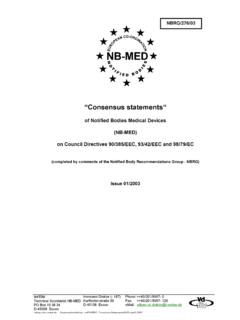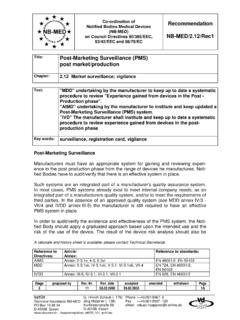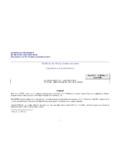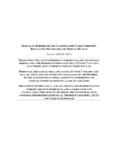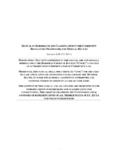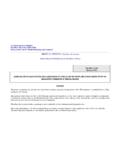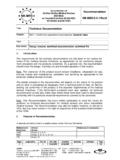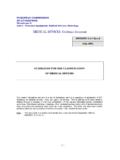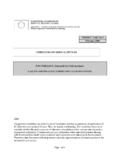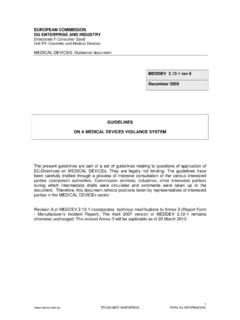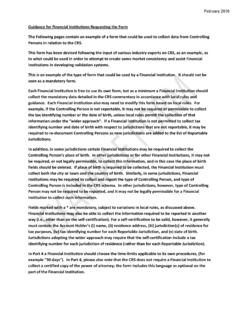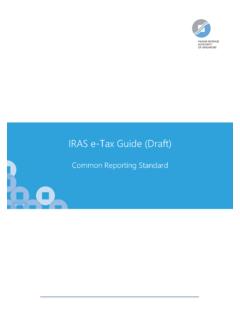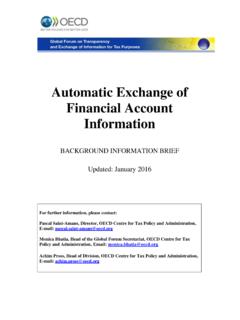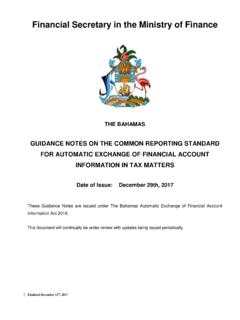Transcription of GUIDELINES ON MEDICAL DEVICES - Productos Sanitarios
1 EUROPEAN COMMISSION DIRECTORATE GENERAL for HEALTH and CONSUMERS Consumer Affairs Cosmetics and MEDICAL DEVICES MEDDEV December 2010 GUIDELINES ON MEDICAL DEVICES CLINICAL INVESTIGATIONS: SERIOUS ADVERSE EVENT REPORTING UNDER DIRECTIVES 90/385/EEC AND 93/42/EEC. The present GUIDELINES are part of a set of GUIDELINES relating to questions of application of EU-Directives on MEDICAL DEVICES . They are legally not binding. The GUIDELINES have been carefully drafted through a process of intensive consultation of the various interested parties (competent authorities, Commission services, industries, other interested parties) during which intermediate drafts were circulated and comments were taken up in the document. Therefore, this document reflects positions taken by representatives of interested parties in the MEDICAL DEVICES sector. These GUIDELINES incorporate changes introduced by Directive 2007/47/EC amending Council Directive 90/385/EEC and Council Directive 93/42/EEC.
2 Page 2 of 6 1. OBJECTIVE This guidance defines Serious Adverse Event (SAE) reporting modalities and includes a summary tabulation reporting format1. Its objective is to contribute to the notification of SAEs to all concerned National Competent Authorities (NCAs2) in the context of clinical investigations in line with the requirements of Annex 7 of Directive 90/385/EEC and Annex X of Directive 93/42/EEC, as amended by Directive 2007/47/EC. According to annex 7 of Directive 90/385/EEC and to annex X of Directive 93/42/EEC: All serious adverse events must be fully recorded and immediately notified to all competent authorities of the Member States in which the clinical investigation is being performed." 2. SCOPE The reporting modalities and format set out in this guidance apply to pre-market3 clinical investigations4-5 conducted with: a. Non-CE marked DEVICES , b. CE marked DEVICES used outside the intended use(s) covered by the CE marking.
3 The tabular format featured in the Appendix needs to be updated for each reportable event or for new findings/updates to already reported events. It shall be transmitted to all NCAs where the clinical investigation is being performed. 3. DEFINITIONS (from ISO/FDIS 14155) Adverse Device Effect (ADE) Adverse event related to the use of an investigational MEDICAL device. NOTE 1- This includes any adverse event resulting from insufficiencies or inadequacies in the instructions for use, the deployment, the implantation, the installation, the operation, or any malfunction of the investigational MEDICAL device. NOTE 2- This includes any event that is a result of a use error or intentional misuse. Adverse Event (AE) 1 A template for individual reporting of SAEs is under preparation to harmonize individual SAE forms in case NCAs require individual reporting for the SAEs occurring within their jurisdictions.
4 Further revisions of these template documents may become necessary in line with the forthcoming corresponding GHTF-Guidance. 2 For the purpose of this guidance," NCAs" encompass the National Competent Authorities of the EU, the EEA and of Switzerland and Turkey. 3 A specific guidance on Post Market Clinical Follow-Up Studies is in preparation. 4 - This includes pre-market clinical investigations: which started prior to 21 March 2010 and are continued after that date. [Note: reporting of SAE as covered in this guidance only started on 21 March 2010 with the implementation of Directive 2007/47/EC and is not SAEs that occurred prior to 21 March 2010]. - For pre-market clinical investigations involving CE marked comparator DEVICES , SAEs occurring in or to subjects that are in the comparator arm of an investigation shall also be reported in accordance with these GUIDELINES . 5 Where the right to bear the CE marking has been obtained before the end of the clinical investigation, the SAE reporting continues until completion of the investigation, according to the clinical investigation plan.
5 Page 3 of 6 Any untoward MEDICAL occurrence, unintended disease or injury or any untoward clinical signs (including an abnormal laboratory finding) in subjects, users or other persons whether or not related to the investigational MEDICAL device. NOTE 1: This includes events related to the investigational device or the comparator. NOTE 2: This includes events related to the procedures involved (any procedure in the clinical investigation plan). NOTE 3: For users or other persons this is restricted to events related to the investigational MEDICAL device. Device deficiency Inadequacy of a MEDICAL device related to its identity, quality, durability, reliability, safety or performance, such as malfunction, misuse or use error and inadequate labeling. Investigational MEDICAL device MEDICAL device being assessed for safety or performance in a clinical investigation NOTE: This includes MEDICAL DEVICES already on the market that are being evaluated for new intended uses, new populations, new materials or design changes.
6 Serious Adverse Device Effect (SADE) Adverse device effect that has resulted in any of the consequences characteristic of a serious adverse event. Serious Adverse Event (SAE) Adverse event that: a) led to a death, b) led to a serious deterioration in health that either: 1) resulted in a life-threatening illness or injury, or 2) resulted in a permanent impairment of a body structure or a body function, or 3) required in-patient hospitalization or prolongation of existing hospitalization, or 4) resulted in MEDICAL or surgical intervention to prevent life threatening illness or injury or permanent impairment to a body structure or a body function. c) led to fetal distress, fetal death or a congenital abnormality or birth defect. NOTE 1: This includes device deficiencies that might have led to a serious adverse event if a) suitable action had not been taken or b) intervention had not been made or c) if circumstances had been less fortunate. These are handled under the SAE reporting system.
7 NOTE 2: A planned hospitalization for pre-existing condition, or a procedure required by the Clinical Investigation Plan, without a serious deterioration in health, is not considered to be a serious adverse event. Unanticipated Serious Adverse Device Effect (USADE) Serious adverse device effect which by its nature, incidence, severity or outcome has not been identified in the current version of the risk analysis report. NOTE: Anticipated: an effect which by its nature, incidence, severity or outcome has been previously identified in the risk analysis report Page 4 of 6 4. reportable EVENTS UNDER ANNEX 7 AND ANNEX X OF DIRECTIVES 90/385/EEC AND 93/42/EEC RESPECTIVELY. For the purpose of this guidance and based on the definitions above, the following events are considered reportable events in accordance with Annex 7, section and Annex X, section of the above mentioned Directives: - any SAE, - any Investigational MEDICAL Device Deficiency that might have led to a SAE if a) suitable action had not been taken or b) intervention had not been made or c) if circumstances had been less fortunate - new findings/updates in relation to already reported events.
8 reportable events occurring in Third Countries6 in which a clinical investigation is performed under the same clinical investigation plan, have to be reported in accordance with this guidance. 5. REPORT BY WHOM. reportable events have to be reported by the sponsor of the clinical investigation, which could be the manufacturer (MFR), the authorized representative (AR) or another person or entity7-8. 6. REPORT TO WHOM. reportable events must be reported at the same time to all NCAs where the clinical investigation has commenced9-10 using the summary tabulation featured in the Appendix. A list of clinical investigation contact points within the NCAs is published at the Commission's homepage. 7. REPORTING TIMELINES Report by sponsor to NCAs. The sponsor must report to the NCAs where the clinical investigation has commenced: a SAE which indicates an imminent risk of death, serious injury, or serious illness and that requires prompt remedial action for other patients/subjects, users or other persons11 or a new finding to it: immediately, but not later than 2 calendar days after 6 Countries other than Switzerland, Turkey and those belonging to the EU and the EEA.
9 7 Note: Member States may also require separate reporting by clinical investigators/ MEDICAL professionals. 8 Note: SAEs concerning CE marked DEVICES ( comparators) which meet the vigilance reporting criteria may also need to be handled under the post-market surveillance/vigilance system. 9 For the purpose of this guidance, an investigation is considered to have commenced in an individual Member State when the sponsor is authorised to start the investigation in accordance with the notification procedures in that Member State. 10 Note: Member States may also require separate reporting to the Ethics Committee(s) and/or separate reporting to the other clinical investigators/study centers involved in the clinical investigation. 11 This includes: - events that are of significant and unexpected nature such that they become alarming as a potential public health hazard, human immunodeficiency virus (HIV) or Creutzfeldt-Jacob Disease (CJD). These concerns may be identified by either the NCA or the MFR.
10 - the possibility of multiple deaths occurring at short intervals. Page 5 of 6 awareness by sponsor of a new reportable event or of new information in relation with an already reported event. any other reportable events as described in section 4 or a new finding/update to it: immediately, but not later than 7 calendar days following the date of awareness by the sponsor of the new reportable event or of new information in relation with an already reported event. Report by the investigator to the sponsor The sponsor shall implement and maintain a system to ensure that the reporting of the reportable events will be provided by the investigator to the sponsor in acceptable timely conditions, but not later than within 3 calendar days after the occurrence of the event. In some cases, a different periodicity or different modalities12 may be agreed by the participating NCAs according to the investigational design and to the pathology under clinical investigation.
